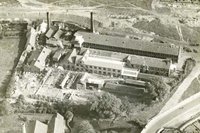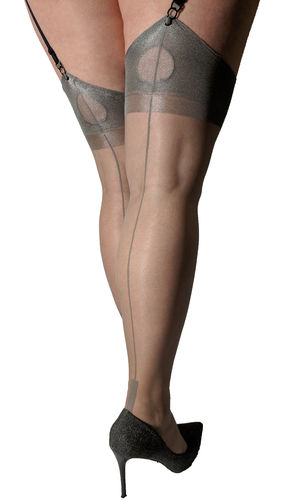Categories Hosiery Lindley & Lindley
Lindley & Lindley

The Hosiery and Lace Manufactures in Georgian and Victorian England
These were the two staple trades of Nottingham, and to them the town owed its rising wealth and magnitude. The hosiery trade was not of much importance till the middle of the eighteenth century, nor that of lace till the year 1778, when the point net machine was invented - an improvement which was superceded in later times by warp and bobbin net machines. Many females used to be employed in the making of bone or cushion lace, till they found a more profitable occupation in ornamenting hosiery and embroidering wrought lace net.
The Lindley and Lindley Hosiery Factory was situated on Alfreton Road in Nottingham and was demolished around 2000, though it had ceased to produce fully-fashioned nylon and silk stockings many years previously. By great fortune, we have acquired some 5000 pairs of silk and nylon and silk stockings, both fully-fashioned with seams and point or cuban heels as well as RHT stockings, some with a plain black seam which is both very rare and highly sought after. All these beautiful nylons have been painstakingly sized, graded and repackaged accordingly. Why not bag yourself a piece of history?
The famous name of Lindley has been inextricably linked with hosiery for centuries. From Nottinghamshire to the Carolinas in the USA, stockings and latterly pantyhose have been developed, improved and perfected.
At Lindley and Lindley Ltd of Essex (est. 1998), we are privileged to continue the proud name and strive to be the very best.
Method for manufacturing pantyhose
United States Patent 5964000
James Thomas Lindley Snr (1927-2019) developed a method for manufacturing pantyhose efficiently all year round. The method includes dyeing and post-boarding the pantyhose during one portion of the year in the normal manner. During slack order times, the pantyhose are pre-boarded, folded and bagged for subsequent dyeing. A portion of the bagged pantyhose are then stored until orders are received and the correct dyes are known. In the preferred embodiment, a dye bag is used having a base portion sized approximately equal to the size of a pair of folded pantyhose. Between about 6 to 12 pair of the pantyhose are folded together before stacking into the dye bag. Between about 1 to 3 dozen of the folded together pantyhose are then dyed in a single dye bag. The pantyhose are then removed from the dye bag, dried, individually folded, and packaged for shipment to the end user.
A native of Burlington, Mr. Lindley was born April 1, 1927 to the late Harvey Winford Lindley and Cassie Elizabeth Mattox Lindley. Mr. Lindley was married for 58 years to the late Mary Ruth Johnston Lindley before her death in 2011. Mrs. Lindley was also a native of Burlington.
Educated at Broad Street School and Burlington High School, Lindley attended Elon College and East Carolina University. During WWII, he was stationed with the US Army in Rosenheim, Germany after training at Camp Croft. For his service, Mr. Lindley earned the Army of Occupation Medal and the World War II Victory Medal.
Lindley’s entrepreneurial spirit showed itself at an early age. As a child, he collected bottles for the deposit money and sold hot popcorn to travelers at the bus station in town. At the age of twenty, Lindley purchased a house to rent for supplemental income. With that income he purchased additional residential and commercial properties in North and South Carolina which he maintained the rest of his life.




















